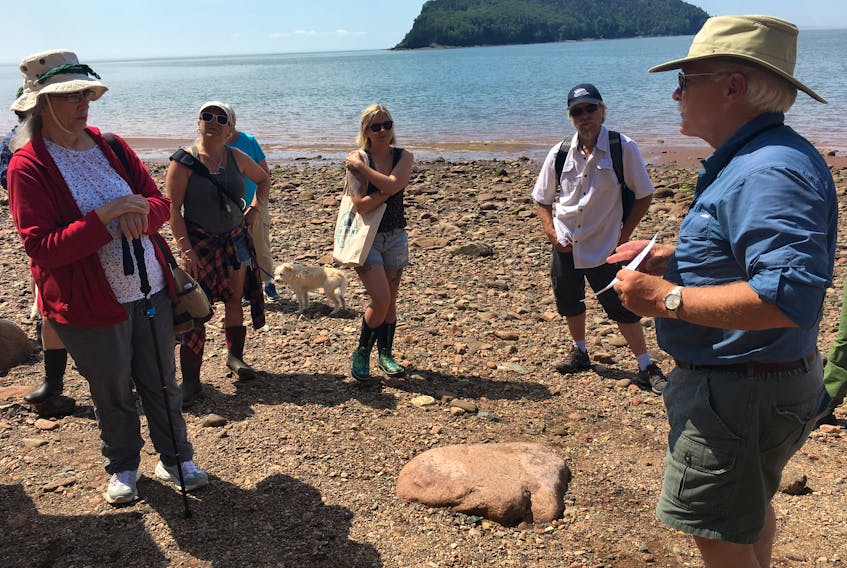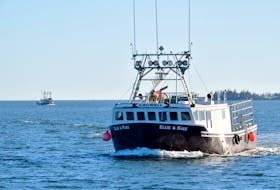FIVE ISLANDS, N.S. — Paul and Alannah Vreeland are fascinated with the geology of Nova Scotia’s Fundy shore.
The Charlottetown, P.E.I. residents were in Five Islands on Aug. 17 to participate in a beach walk with Saint Mary’s University geology professor Howard Donahoe about the uniqueness of the cliffs that line the bay and the role they played in the creation of the modern world.
“This is the second time we’ve come for this geological tour with Howard. The first one was about 10 years ago, so this was a refresher,” Paul said after taking part in the 90-minute tour at Five Islands Provincial Park. “When you hear it the second time it’s all the more clearer.”
A group of approximately 20 people – and two dogs – participated in the tour listening as Donahoe explained how the cliffs that line the Bay of Fundy as well as the islands that make up Five Islands were formed millions of years ago before and during a time when dinosaurs of all shapes and sizes roamed the area.
“We love the Bay of Fundy,” Alannah said. “We also love the geology.”
For her husband, he’s thrilled to see the work of people like Eldon George in Parrsboro and Don Reid in Joggins is being recognized and honoured by Nova Scotia.
“I look at what they did and you have amateur geologists who put Nova Scotia on the map,” he said.
Donahoe said the Fundy shore around the Parrsboro and Five Islands area is so important because it represents a real change in the geology and history.
“Not only are we looking out to a spectacular vista, but we are also looking out to an area where there were dinosaurs and the evolution of dinosaurs,” he said. “What makes it important is the presence of the earliest known dinosaur and all the changes that took place with the first of the extinctions and after that we have a change that allowed mammals to develop as well as all the big dinosaurs that came later.”
Donahoe said the cliffs that stretch along both sides of the bay in Cumberland and Colchester counties on one side and several counties on the Annapolis Valley side were formed in the time of the super-continent known as Pangea.
“This area dates back to Pangea that formed 350 million or 360 million years ago and lasted for more than a hundred million years. When you look at the rocks in Five Islands Provincial Park you begin to see how Pangea was breaking up as the continents drifted apart,” Donahoe said. “This was not just here, but in Connecticut, Pennsylvania, Georgia, Virginia and Greenland. The split was happening all along the east coast as the Atlantic Ocean was being created.”
He said the areas along the eastern part of the continent, such as Five Islands, are examples of arrested rift development and he said one of the interesting things about the proposed Cliffs of Fundy Aspiring Global Geopark is it captures the entire shoreline from Cape Chignecto at Advocate Harbour to Debert
“There’s such a diversity of geology that’s so rich,” he said.
Donahoe said everyone has to relate to their past and going deep in the province’s geological past does that. Also, people have to know where they’ve come from, where they’re at and where they could be going.
After the major extinction event, represented in the rocks at Five Islands, two different lines of animals evolved including the mammals from which man evolved and the big dinosaurs that dominated the planet and then disappeared a 100-million years later.
“The other reason why geology is so important is that there are grave problems that come from geological processes. You are looking at the faults to see if they’re still moving or if the cliff face is about to give way. All of these things and climate change and its impact are important and show how geology continues to be important,” he said.
While many geologists look to the past, Donahoe said it’s also important to look to the future on a planet that’s going to see a lot more water as sea levels rise.
Regan Maloney, fossil lab manager at the Fundy Geological Museum, said events such as Donahoe’s tour of the beach at Five Islands help educate people about their past.
“A lot of people in Nova Scotia, when they think about dinosaurs and fossils, they immediately thing of Alberta,” she said. “We have amazing fossils and geology right here in Nova Scotia such as Five Islands, the Joggins Fossil Cliffs and Wasson’s Bluff. A lot of them are world class.”
Maloney said people who participate in the tours are excited about what they learn the response to 54th Gem and Mineral Show as a whole was favourable.
She said people love walking the beach and picking up rocks. However, she said it’s important to remember that it’s illegal to take fossils off a beach.
“It’s fun to go out and see if you can find fossils, but if you find one leave it where it is and notify us at the museum. It’s best for us to come collect it.”









